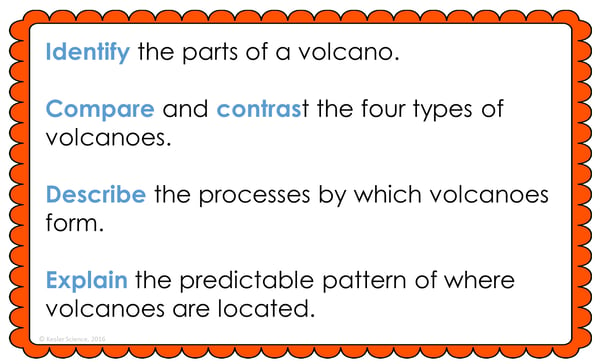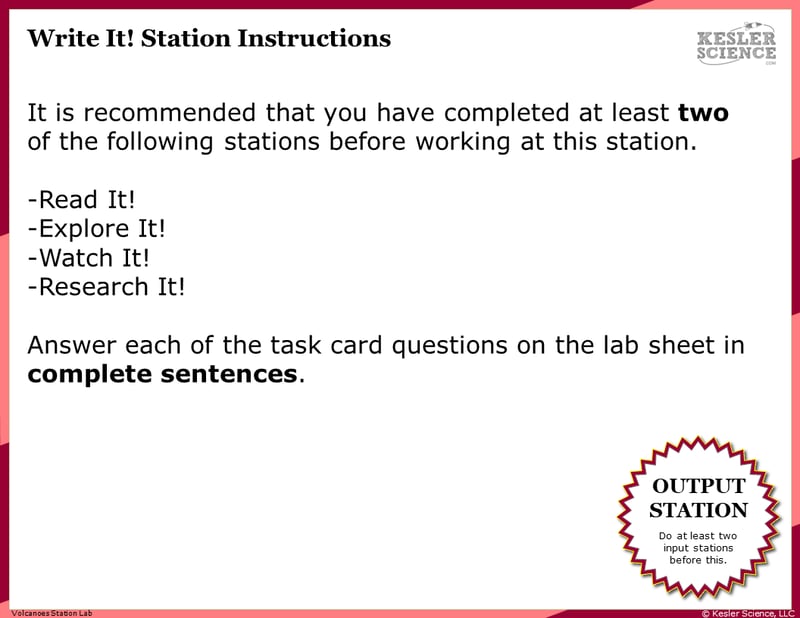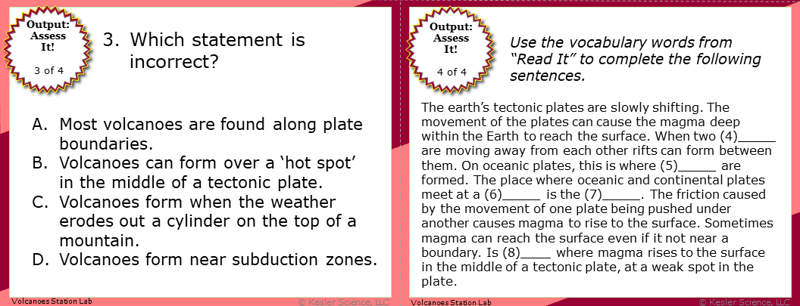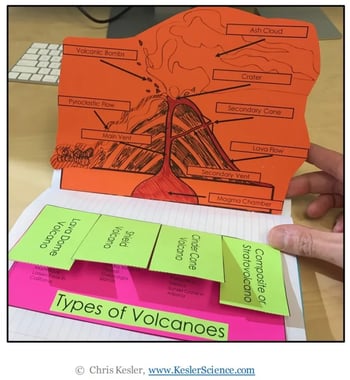Volcanoes Lesson Plan – A Complete Science Lesson Using the 5E Method of Instruction
By the end of this lesson plan about volcanoes, students will be able to identify the parts of a volcano, compare and contrast the four types of volcanoes, describe the processes by which volcanoes form, and explain the predictable pattern of where volcanoes are located. Each of our lessons is designed using the 5E method of instruction to ensure maximum comprehension by the students. This well-thought out unit does the heavy lifting, giving teachers easy-to-implement, highly engaging lesson plans.
This blog will walk you through each of the steps and activities from the Volcanoes 5E Lesson Plan.
ENGAGEMENT
Objective Introduction
At the beginning of the lesson, the class will do a Think-Pair-Share to discuss the objective.
Class Activity
Watch the video indicated in the lesson.
Student Activity
- Ask these questions to students after watching the video:
- Scientists didn’t know much about how volcanoes work until they discovered “what” about the earth’s crust? (Theory of Plate Tectonics)
- Where does the heat for a volcano come from? (Inside the Earth)
- What are two things that happen at plate boundaries creating volcanoes? (converge and diverge)
- Ask students what they already know about volcanoes. Make a list of words associated with volcanoes.
- Tell them they will be learning about the volcanoes, how they form, the four different types, where they form, and their features.

Afterwards, the teacher will help to clear any misconceptions their students may have about volcanoes. A common but major misconception, for example, is that students believe all volcanoes are the same - understanding how they form but not seeing how the small details matter or why.
Estimated Class Time for the Engagement: 20-30 minutes
EXPLORATION
With nine stations in total, you can introduce volcanoes to your middle school students in a variety of ways! Four of these stations are considered input stations where students will learn new information about volcanoes, and four of the stations are output stations where students will be demonstrating their mastery of the lesson's material. A bonus station offers challenges for your early finishers and independent learners. You can read more about how I set up the station labs here.
Watch It!
At this station, students will be watching a short video explaining how volcanoes are formed. Students will then answer questions related to the video and record their answers on their lab station sheet. For example: What did scientists previously think volcanoes were, and what do they know now? Why are most volcanoes found along plate boundaries? Compare eruption of a composite volcano to a shield volcano.
Read It!
This station will provide students with a one-page reading about where volcanoes are formed. Students will read information about what types of boundaries create volcanoes. Students will also where the magma that spills or shoots out of volcanoes come from. There are four follow-up questions that the students will answer to demonstrate their comprehension of the reading material.
Explore It!
Students will be working in pairs to better understand volcanoes. Students will be using images of the four types of volcanoes to try to match characteristics to the correct volcano. Students will read information, and then create models of volcanoes using Play-Doh. They will record their observations on their lab sheet.
Research It!
The research station will allow students to read explore volcanism. Students will click tabs as they research information about the four types of volcanoes, where volcanoes are located and what forms volcanoes. Students will also learn, by learning on their own, about hot spots. Students will be instructed to complete a few tasks and record answers on their lab sheets.
Organize It!
The Organize It station allows your students to match the correct term with the definition, description and picture of volcanoes. Once students have completed their organization, the teacher will come and check their understanding.
Illustrate It!
Your visual students will love this station. Students will draw a diagram of a volcano and label the parts correctly. Students may use the internet and the accompanying diagram/keyword list as a reference.

Write It!
Students who can answer open-ended questions about the lab truly understand the concepts that are being taught. At this station, the students will be answering three task cards: Describe the three main ways that volcanoes are created. Compare and contrast a composite volcano and a shield volcano. How are plate boundaries related to volcanoes?
Assess It!
The Assess It station is where students will go to prove mastery over the concepts they learned in the lab. The questions are set up in a standardized format with multiple choice answers. Some questions include: Where are volcanoes generally formed? Which is true about shield volcanoes? Which statement is incorrect? What should #11 be labeled?

Challenge It! - Bonus Station
Early finishers and advanced students will love the extension activities in this station. Four activity choices offer them ways to expand their learning through mini-games and mini-projects.
Estimated Class Time for the Exploration: One or two 45-minute class periods
EXPLANATION
The explanation activities will become much more engaging for your class once they’ve completed the exploration station lab. During the explanation piece of the lesson, the teacher will be clearing up any misconceptions their students may have about volcanoes with a variety of materials. These materials include on-level and modified versions of the interactive presentation (may be used individually or projected), anchor charts, and paper or digital interactive notebook activities. If you have students that need modified notes, the 5E lessons come equipped to help give every student access to the lesson.

Interactive notebook samples: Above-left is a digital INB activity slide; above-right is an example of the paper INB activities.
The students will also be interacting with their journals using INB templates for volcanoes. Each INB activity is designed to help students compartmentalize information for a greater understanding of the concept. The volcanoes INB templates allow students to focus their notes on understanding the four different types of volcanoes and the parts of a volcano.
Estimated Class Time for the Exploration: Two or three 45-minute class periods
ELABORATION
The elaboration section of the 5E method of instruction gives students choices that allow them to prove they’ve mastered the concepts behind the lesson. When students are given a choice, they’re much more enthusiastic and invested in the project than they are when their teachers choose their projects for them. There are a total of nine choices to demonstrate understanding of volcanoes. A separate set of choices that offer more teacher support are also available for students that need them. Rubrics guide students to doing their best work and assist in grading.

Estimated Class Time for the Elaboration: Two or three 45-minute class periods (can also be used as an at-home project)
EVALUATION
The final piece of the 5E model is to evaluate your students' comprehension. Included in every 5E lesson is a homework assignment, assessment and modified assessment. Research has shown that homework needs to be meaningful and applicable to real-world activities in order to be effective. When possible, I like to give open-ended assessments to truly gauge the student’s comprehension.
Estimated Class Time for the Elaboration: One 45-minute class period
DOWNLOAD THE FULL LESSON NOW
Download Over $100 in FREE Resources
For Middle School Science
Simply create a login below and gain immediate access to a selection of our Kesler Science product line worth $100 - for FREE. There's a full version of every product type! You'll also join tens of thousands of middle school science teachers who receive timely tips and strategies straight to their inbox.







